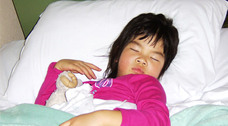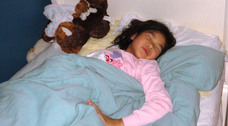
Our bodies have internal systems that work like clocks and determine the time of day we fall asleep, how long we sleep for, and the quality of our sleep. These systems do not work alone, however. Our physical and social environments play a pivotal role in how our natural rhythms play out. These influences are especially important for children as they may not have control over their surroundings.
The dual model of sleep
Sleep is an essential process that occurs on a 24-hour schedule. Our bodies use two separate processes to ensure that we are awake and alert by day and drowsy by night.
- Sleep drive: This process works in a simple way – the longer we stay awake, the more our bodies want to go to bed. And when we do fall asleep, this drive decreases throughout our slumber.
- Circadian process: This second process is controlled by an internal clock and is in charge of timing when we are alert and when we are sleepy. It keeps us alert by balancing out our sleep drive until the evening and by stimulating us more and more throughout the day. Come nightfall, the clock’s stimulating signal drops off, and other signals kick in allowing our body to get the sleep it needs.
Developmental aspects of sleep
Sleep patterns change throughout childhood and adolescence. Two major changes take place during this period:
- First, sleep becomes more consolidated; that is, rather than napping during the day, older children start to sleep longer at night and reduce the amount of naps they need. By adulthood, we sleep for one prolonged period of time during the night only.
- Second, the time we spend in bed changes: as children get older they need less sleep.
Around puberty, young people go through several changes that affect their sleep. Early adolescents develop a preference for going to bed later although they still need to wake up early for school. This often results in the loss of essential sleep time. Most teenagers try to make up for this loss on the weekends by sleeping in, which may satisfy their sleep drive but push their circadian clocks even further out of sync with their weekday schedules. Thus, a cycle of increased sleep deprivation may bring about weekday and weekend schedules that differ greatly.
How much sleep do children need?
There is no “correct” amount of sleep that children should be getting every night according to their age. What determines the right amount of sleep for each child is that he or she wakes up feeling well-rested and this amount varies greatly between individuals. Average sleep durations and the average number of naps needed for specific age groups are given in the table below.
| Age group | Age | Hours of sleep needed on average every 24 hours | Number of naps taken on average every 24 hours |
| Newborn | 0-3 months | 14-17 | 3-10 |
| Infants | 4-11 months | 12-15 | 1-4 |
| Toddlers | 1-2 years | 11-14 | 1-2 |
| Preschoolers | 3-5 years | 10-13 | 0-1 |
| School-aged | 6-13 years | 9-11 | 0* |
| Teenagers | 14-17 years | 8-10 | 0* |
| Youg Adults | 18-25 years | 7-9 | 0* |
| Adults | 26-64 years | 7-9 | 0* |
*Daily napping in older children and adults occurs in some tropical region cultures. Table adapted from the National Sleep Foundation
Sleep, learning and memory

Sleep affects the “consolidation”, or reinforcement of memory which leads to learning facts or skills. Sleep deprivation can disrupt this consolidation, decreasing memory formation and inhibiting learning processes.
Studies on adult populations have provided compelling evidence that the consolidation of newly acquired information into memory takes place during sleep. However, we do not yet fully understand the role of sleep in learning and memory in children and youth. The long-term goal of the Sleep to Remeber study is to understand the interplay between sleep and cognitive development. The objective of this study is to characterize the interplay between sleep and the systems that regulate learning and memory in children and adolescents.
Sleep and behaviour
Studies have shown that a lack of sleep impairs how students manage their emotions. Furthermore, youths with sleep problems are more likely to have trouble with mood swings and depression. Sleep complaints are also common amongst children diagnosed with Attention-Deficit Hyperactivity Disorder (ADHD) and anxiety.
Sleep and attention
Attention can suffer in many ways when youths do not get enough sleep. The following all contribute to daytime functioning, and are all impaired by lack of sleep:
- Alertness, which describes how awake and aware we are
- Executive attention, which describes how well we are able to pay attention in the presence of competing stimuli
- Vigilance, which describes how well we pay attention to things for long periods of time
Conversely, children with attention deficit often have sleep problems. Some findings suggest that they have unstable sleep patterns, a harder time falling asleep, and more daytime sleepiness. For a thorough examination of ADHD and sleep disorder, please refer to Reut Gruber's ABS lab section.
This content was developped by Reut Gruber, PhD, thanks to the support of Manulife.
[Sleep and children: the science behind it] [Sleep disorders in children] [Sleep and children: the impact of lack of sleep on daily life] [Sleep and children: practical advice] [Sleep and youth : five common myths]


